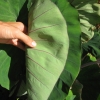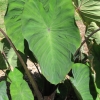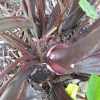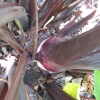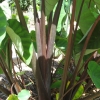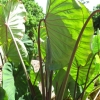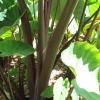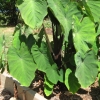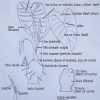Use As Food
Oha used mainly as table taro; Hā (Petiole) stalks sometimes sold as greens; sprouts from small ‘ohā grown in darkness sold in limited amount.
Distribution
Grown sparingly, almost entirely by Japanese gardeners in small patches, usually under dryland culture (māla).
General Characteristics
Medium in height to tall, stiffly erect, stocky, maturing within 10 months, producing more than 20 ‘ohā which remain dormant for several weeks; outstanding among the Japanese taros because of the vivid Hā (Petiole) coloring.
Ha (Petiole)
60 to 90 cm. long, greenish-bronze shading into dark reddish-purple at kōhina (base) and apex, indistinctly edged, curved abruptly at apex so that blade hangs more or less vertically.
Lau or Lu'au(Leaf Blade)
40 to 55 cm. long, 30 to 40 cm. wide, 35 to 45 cm. from tip to base of sinus, broadly egg-shaped (ovate), firm-chartaceous (paper like), dark green with bluish cast, often tinged with purple on lower surface when young, with conspicuous purple veins on lower surface; piko prominent, purple; round leaf section (lobes) acute with shallow, wide lihi mawae (sinus).
'I'o kalo (Corm)
Flesh white with yellowish fibers; skin purple; ‘ohā usually 4 to 6 cm in diameter.
Pua (Flower)
Remarks
The parent kalo (Corm) are edible but an aversion to them exists because of their extreme acridity (bitter). This variety is highly resistant to disease. It has the largest ‘ohā of the Japanese taros and probably has the best quality but is grown only to a limited extent because of its comparatively poor keeping quality.

